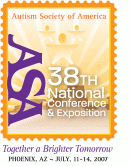 |
The ASA's 38th National Conference on Autism Spectrum Disorders (July 11-14, 2007) of ASAThe Westin Kierland Resort & Spa, Scottsdale, AZ |
| For a complete author index with session numbers, please click here | |
| Thursday, July 12, 2007: 10:45 AM-12:00 PM | |||
| Cushing A & B | |||
| #2970- Our Journey to Eliminate the Use of Physical Restraint* | |||
| This session will examine in great detail the journey of the Winchester Region of Grafton School to eliminate the use of physical restraint. It will provide actual examples of how we set goals and met them, how we created a culture of respect for the individuals we serve, and how we were able to get the support and enthusiasm of Direct Support Professionals as they were affected the most. A practical action plan will be handed out for other organizations to use. | |||
| Presenters: | - Kim has worked with children and adults with Autism and other developmental disabilities for nearly 20 years. Kim is currently the Executive Director of the Winchester Region of Grafton School in Winchester, VA. She is also an active member of the National Association of Residential Providers of Adults with Autism (NARPAA). Kim’s education includes a BS in Psychology and a MS in Strategic Leadership. Kim presented at the 2006 ASA conference on Residential Standards with fellow NARPAA members.
- Stacey has worked with children and adults with Autism and other developmental disabilities for over 20 years. Her area of expertise is supporting adults with Autism and Mental Retardation. She is currently the Adult Services Administrator in the Winchester Region of Grafton School in Winchester, VA. She is also an active member of the National Association of Residential Providers of Adults with Autism (NARPAA). Stacey’s education includes a BS in Organizational Leadership and a MS in Strategic Leadership. - Ray has worked with children with Mental Retardation for over 15 years. He specializes in creating systems to ensure high quality services are provided in a residential setting. He is also masterful in implementing action plans for major cultural and operational change. Ray is currently a House Manager in the Winchester Region of Grafton School in Winchester, VA. | ||
|
| |||
|
In some cases individuals with Autism or other developmental disabilities also experience behavioral challenges such as physical aggression towards others and/or self injurious behavior. The acts of aggression come in various degrees of intensity; however, one thing typically remains constant. The factor that is constant is that the physical aggression is a form of communicating when other means are not available or are not effective. Regardless of the intent, historically in the United States, moderate to severe aggression has been managed through the use of mechanical restraint, physical restraint, and seclusion. As time passes and the world gains more knowledge and understanding, we are forced to look at situations differently and to adapt as best practices change. The Winchester Region has served individuals with Autism and other developmental disabilities accompanied by challenging behaviors. Over the years we have used various de-escalation strategies, however, when those failed physical restraint was used to maintain safety. An example of one of our highest months of data was in 2003. We had 260 physical restraints for a total duration of 3800 minutes. Our Chief Executive Officer mandated that we move toward the elimination of physical restraint by January 2007 with the understanding that no one's safety could be compromised. That is where the journey began. Today we have a feeling of success. In October 2006 we had 5 physical restraints for a total duration of 20 minutes. The population of the individuals we serve has not changed and our census has actually grown. Five physical restraints are more than we want, but our journey continues. This session will examine in great detail the journey of the Winchester Region of Grafton School to eliminate the use of physical restraint. It will provide actual examples of how we set goals and met them, how we created a culture of respect for the individuals we serve, and how we were able to get the support and enthusiasm of Direct Support Professionals as they were affected the most. The following are the steps that were taken (each area will be covered in detail in the presentation): 1. Plan the Work and Work the Plan-designing a realistic action plan 2. Communicate, Communicate, Communicate-proving multiple avenues and forums to disseminate information 3.Reporter on the Street-strategy of identifying influential staff to help spread the word and get feedback. This helped to build support for the initiative and employees really felt that they were able to give input on the process. 4.Comprehensive Assessments-targeted individuals who were at high risk for the use of physical restraint and did complete evaluations which included emphasis on medical issues. 5.Training of Alternative Strategies-provided training to everyone on alternatives strategies. This proved to be extremely important as employees must have replacement tools when the only tools they know are being eliminated. 6.Support by Presence-management, administrators, and the director have to be present to gain trust. This means actually working evening, weekends, and overnights. 7.An Avenue for Learning-detailed debriefing process when a physical restraint does occur. The process is supportive and focused on sharing learnings not placing blame. The primary learning that we would like others to take away from this session is that physical restraint is not the only answer. Other alternatives are just as effective and much safer. We want others to be encouraged to take our learnings back to their organization and eliminate the use of physical restraint. |
|||
See more of General Submissions
See more of The ASA's 38th National Conference on Autism Spectrum Disorders (July 11-14, 2007)